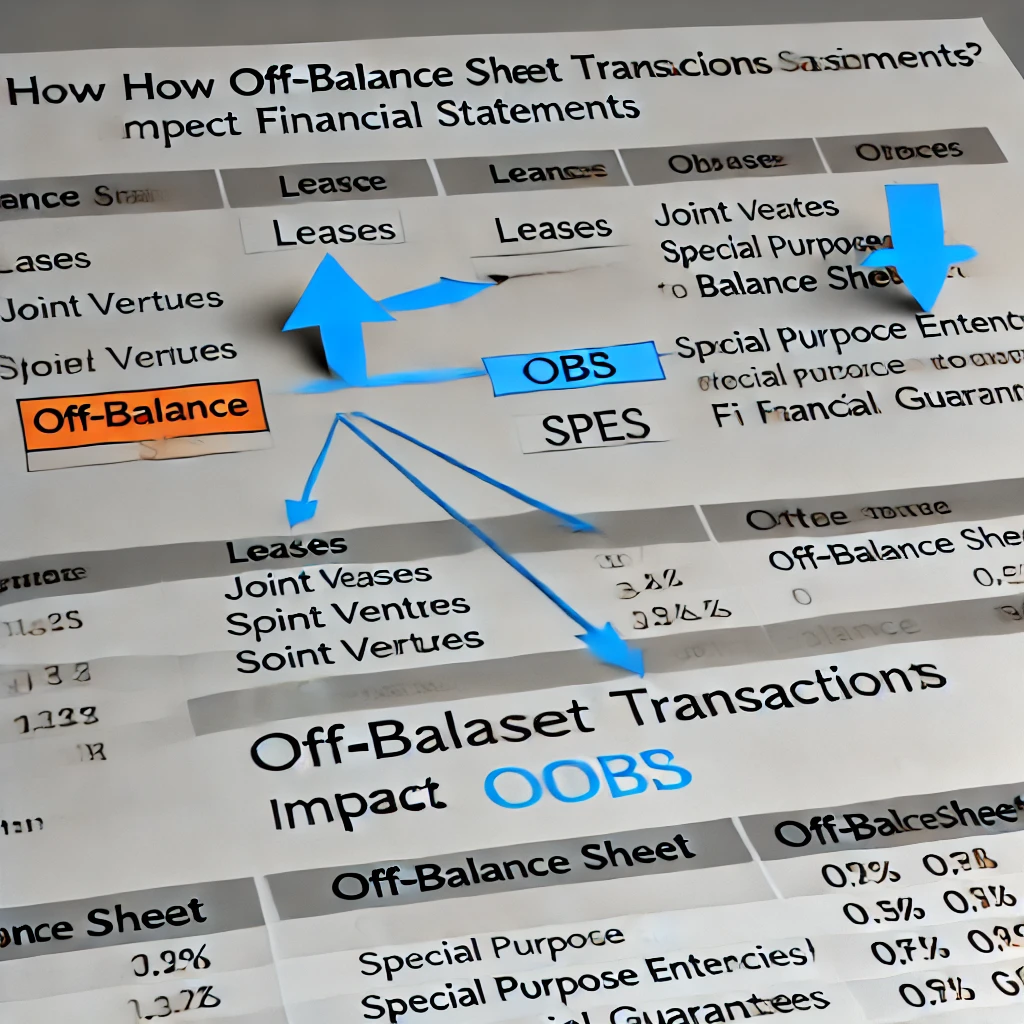How OBS Transactions Impact Financial Statements
Definition of OBS Transactions
Off-balance-sheet (OBS) transactions refer to financial activities that are not recorded on the company’s balance sheet. These transactions exist off the main financial statements and usually involve partnerships, leases, or other types of financial instruments. For instance, operating leases are a common type of OBS transaction. By keeping these transactions off the balance sheet, companies can manage their financing and risk strategies more flexibly.
Importance of OBS Transactions in Financial Analysis
Understanding the role of OBS transactions is essential for accurate financial analysis. These transactions can significantly affect a company’s financial health and risk profile. Here’s why they matter:
- Transparency: Sometimes, companies use OBS transactions to hide liabilities, making financial statements appear healthier than they are. Analyzing OBS can provide a more transparent view of the company’s fiscal responsibilities.
- Risk Evaluation: OBS transactions often carry risks that are not immediately apparent. By digging deeper into these transactions, analysts can better assess a company’s risk exposure.
- Regulatory Compliance: Certain regulations require thorough disclosure of OBS transactions. Understanding these helps ensure that companies are in compliance with financial reporting standards.
For example, in the Enron scandal, the misuse of special purpose entities (SPEs) as off-balance-sheet tools played a crucial role in the company’s collapse. This underscores the necessity of vigilance and thorough examination of OBS transactions in financial statements.
Types of Off-Balance-Sheet Transactions
Off-balance-sheet (OBS) transactions can significantly affect a company’s financial health without explicitly appearing on its balance sheet. Let’s delve into two common types of OBS transactions: Operating Leases and Special Purpose Entities (SPEs).
Operating Leases
Operating leases are a prevalent form of OBS transactions. Unlike capital leases, operating leases do not appear on the balance sheet as long-term liabilities. Companies often use operating leases to manage:
- Office Space and Equipment: Many businesses lease office spaces and essential equipment instead of purchasing them outright. This allows them to preserve cash flow and maintain flexibility.
- Avoiding Asset Ownership: Some companies prefer not to own high-maintenance assets. For example, a tech startup might lease servers instead of purchasing them, avoiding the depreciating asset on their balance sheet.
Consider personal experiences with leased items like a car or apartment. These are similar to operating leases where you enjoy the benefits without the burden of ownership.
Special Purpose Entities (SPEs)
Special Purpose Entities (SPEs) are created to isolate financial risk. These entities can:
- Enhance Funding: Companies can securitize assets, transferring them to an SPE to raise capital without listing the debt on their own balance sheet.
- Risk Management: SPEs are used to separate financial risk associated with specific projects. One famous example involves Enron, which created numerous SPEs to hide its liabilities and overstate earnings.
However, misuse of SPEs can lead to significant financial scandals, underscoring the importance of transparent reporting and adherence to regulations.By understanding the roles of operating leases and SPEs, investors can gain better insight into a company’s true financial position beyond the traditional balance sheet.
Accounting Principles Governing OBS Transactions
Understanding the accounting principles behind Off-Balance-Sheet (OBS) transactions is crucial. It helps in deciphering how these maneuvers are reported and ensures transparency in financial statements.
US GAAP and IFRS Guidelines
When it comes to OBS transactions, both US GAAP (Generally Accepted Accounting Principles) and IFRS (International Financial Reporting Standards) have specific rules and guidelines:
- US GAAP: Emphasizes a detailed and principles-based approach. For instance, before 2016, operating leases weren’t recognized on the balance sheet. However, with the introduction of ASC 842, companies must recognize assets and liabilities for leases exceeding 12 months.
- IFRS: Adopts a more principles-based approach, emphasizing the substance over form. IFRS 16, effective from 2019, mandates the recognition of most leases on the balance sheet, aiming to improve transparency and comparability.
Both sets of standards aim to ensure that OBS transactions do not obscure a company’s real financial health.
Disclosure Requirements
Disclosure is a fundamental part of transparency in financial reporting. Companies are required to provide ample information about OBS transactions. This includes:
- Footnotes: Detailed explanations in the footnotes of financial statements regarding the nature and extent of OBS arrangements.
- Management Discussion and Analysis (MD&A): A narrative section where management discusses the financial condition and results of operations, including risks associated with OBS transactions.
- Specific Disclosures: Additional disclosures may be required, such as the terms of lease agreements, any special purpose entities involved, and obligations not included in the balance sheet.
Proper disclosure helps investors and stakeholders understand the impact of OBS transactions on the company’s financial position, aiding in better decision-making.Navigating through US GAAP and IFRS guidelines can be complex, but it’s essential for ensuring transparency and maintaining the trust of investors and stakeholders.
Impacts on Financial Statements
When discussing Off-Balance-Sheet (OBS) transactions, it’s crucial to understand how they influence financial statements. These impacts can be quite significant, especially when accounting for balance sheets and income statements.
Balance Sheet Implications
OBS transactions, by nature, do not appear on the balance sheet directly. This means that liabilities and assets tied to these transactions are not recorded on the balance sheet, which can paint an incomplete picture of a company’s financial health. For example, if a company uses operating leases, the leased assets and associated liabilities won’t appear on the balance sheet.Here’s a quick breakdown:- Assets: Appear smaller than they actually are because leased properties or assets owned by Special Purpose Entities (SPEs) are not included.- Liabilities: Seem lower as future lease payments or obligations through SPEs are kept off the books.- Equity: Can appear artificially inflated since off-balance-sheet financial engagements aren’t immediately recognized.Consider an instance where I worked with a tech startup that had numerous operating leases. Initially, their balance sheet looked robust; however, understanding their substantial lease commitments was essential to grasp the real financial state.
Income Statement Effects
The income statement can also be affected by OBS transactions, though these impacts are often indirect. For instance, expenses related to operating leases are reported as rental expense rather than interest and depreciation. This can lead to:- Operating Income: Appearing higher due to the absence of depreciation and interest expenses on the leased assets.- Net Income: Remains unaffected but can be misleading if operating performance paints an incomplete picture.From my past consulting days, I recall a manufacturing firm that leveraged Special Purpose Entities for equipment leases. While their income statement showed robust operating income, delving deeper into their financials revealed off-balance-sheet arrangements impacting their true operational profitability.Understanding these nuances in financial statements can provide a more comprehensive insight into a company’s actual financial health, aiding better decision-making for investors and analysts.
Risk Management and OBS Transactions
Transitioning from the impacts on financial statements, the focus now shifts to risk management concerning off-balance-sheet (OBS) transactions. Evaluating and managing these risks is crucial for maintaining financial health.
Risk Assessment
It’s essential to thoroughly assess the risks associated with OBS transactions, given their potential to obscure a company’s true financial position. Common risks include:
- Financial Instability: OBS items can mask liabilities, leading to a misinterpretation of a company’s leverage.
- Reputational Risk: Misleading financial statements can damage a company’s reputation if issues come to light.
- Regulatory Scrutiny: Non-disclosure or improper accounting can lead to legal consequences.
Investors and analysts often delve into footnotes and disclosures to uncover hidden risks with such transactions. For instance, during my time as a junior analyst, I spotted inconsistencies in a firm’s lease obligations through careful footnote analysis. This revealed underlying financial strains that were initially masked by OBS maneuvers.
Mitigation Strategies
To mitigate risks associated with OBS transactions, companies can implement several strategies:
- Enhanced Transparency: Providing detailed disclosures can ease investor concerns and build trust.
- Robust Internal Controls: Establishing stringent internal control mechanisms to monitor OBS transactions can prevent discrepancies.
- Regular Audits: Conducting regular internal and external audits ensures that all transactions are accounted for correctly.
- Scenario Analysis: Performing worst-case scenario analysis to understand the potential impacts of OBS transactions on financial stability.
Applying these strategies not only helps in risk management but also ensures compliance with regulatory standards, safeguarding the company’s long-term reputation and financial health. For instance, after an industry-wide scandal, a firm I consulted significantly improved its disclosure practices, resulting in regained investor confidence.Next, we will delve into examples of OBS transactions in practice, highlighting real-world scenarios where they played a pivotal role in corporate financial maneuvering.
Examples of OBS Transactions in Practice
Transitioning from understanding the impact of OBS transactions on financial statements, let’s delve into real-world examples. Examining past case studies helps highlight the practical implications and risks associated with off-balance-sheet activities.
Case Study: Enron
The Enron scandal is one of the most infamous examples of misuse of off-balance-sheet transactions. Here’s how they managed it:
- Special Purpose Entities (SPEs): Enron created SPEs to hide debt and inflate profitability. These entities kept liabilities off Enron’s main balance sheet, making the company appear financially stronger than it was.
- Complex Financial Instruments: Enron used complex financial contracts and derivatives to manipulate earnings and conceal losses. This made it extremely hard for analysts and investors to understand the company’s true financial health.
The outcome was disastrous. When the deceptions came to light, Enron’s stock price plummeted, and the company filed for bankruptcy in December 2001. Thousands of employees lost their jobs and savings, demonstrating the catastrophic effects of misleading OBS transactions.
Case Study: Lehman Brothers
Lehman Brothers’ bankruptcy in 2008 was another case where OBS transactions played a critical role. Key points include:
- Repo 105 Transactions: Lehman used repo transactions, known internally as Repo 105, where they temporarily sold assets with an agreement to repurchase them within a short period. This technique allowed Lehman to remove up to $50 billion of assets from its balance sheet, reducing leverage ratios and appearing financially robust.
- Lack of Transparency: The complexity and opacity of these transactions misled investors and regulators. When the housing market collapsed, Lehman’s fragile financial state was laid bare, leading to its downfall and triggering a broader financial crisis.
These case studies show how companies can misuse OBS transactions to obscure the true state of their liabilities and risks. They serve as stark reminders of the importance of transparency and rigorous financial analysis.
Regulatory Changes and Their Effects
Regulatory changes have had a profound impact on how off-balance-sheet (OBS) transactions are handled and reported. By setting stringent guidelines and rules, these regulations aim to enhance transparency and honesty in financial reporting.
Sarbanes-Oxley Act
The Sarbanes-Oxley Act (SOX), introduced in 2002, was a landmark regulation enacted in response to major financial scandals like Enron. SOX fundamentally changed the landscape of financial reporting.
- Increased Accountability: As a result of SOX, CEOs and CFOs must personally certify the accuracy of their company’s financial statements.
- Enhanced Disclosure: SOX mandates rigorous disclosure of off-balance-sheet arrangements, ensuring investors have a clearer picture of a company’s obligations.
One striking impact was the increased cost of compliance for companies, but many argue that the benefits of enhanced transparency far outweigh these costs.
FASB Regulations
The Financial Accounting Standards Board (FASB) has also been instrumental in reshaping OBS transaction reporting.
- Changes in Lease Accounting: FASB’s Accounting Standards Update (ASU) 2016-02 required operating leases to be recorded on the balance sheet, effectively eliminating a significant off-balance-sheet item.
- Improved Financial Statements: These regulations aim to provide a more accurate representation of a company’s financial health, promoting better investment decisions.
Both SOX and FASB regulations have made financial statements more reliable and have reduced the scope for hiding liabilities. This regulatory evolution has brought much-needed trust and clarity to financial markets.
Detecting OBS Transactions in Financial Statements
Understanding how off-balance-sheet (OBS) transactions impact financial statements is crucial for accurate financial analysis. The previous sections have detailed the nature and implications of these transactions. Let’s now dive into practical steps to detect these transactions in financial statements.
Analyzing Footnotes
Footnotes in financial statements can be a treasure trove of information. Companies are required to disclose details about OBS transactions in the notes accompanying their financial statements. Here are some tips:
- Read the Notes Carefully: The footnotes will often detail commitments, contingencies, and any relationships with special-purpose entities (SPEs).
- Look for Keywords: Terms like “lease obligations,” “guarantees,” “commitments,” and “SPEs” can hint at OBS transactions.
- Cross-reference Financial Statements: Footnote details should ideally align with the information presented in the balance sheet and income statement.
For instance, in my experience, I once analyzed a company’s financial statements where the footnotes revealed significant operating leases that weren’t immediately apparent from the balance sheet itself.
Red Flags to Watch For
Detecting red flags early can prevent potential pitfalls. Here are some commonly observed red flags:
- Sudden Changes in Footnotes: If the notes show sudden and large commitments or new SPEs, it might indicate recent OBS transactions.
- Complex or Vague Language: Companies might use complex jargon to obfuscate risky financial maneuvers. A footnote that seems unnecessarily complicated could be a red flag.
- Mismatches: Significant disparities between footnote details and main financial statement figures warrant further investigation.
By keeping an eye out for these red flags, investors and analysts can better protect their interests and gain a clearer understanding of a company’s financial health.
Investor Considerations
When it comes to investing, understanding a company’s financial health is paramount. Off-balance-sheet (OBS) transactions can be particularly perplexing, but they are vital to ensuring a comprehensive risk analysis.
Analyzing Company Risk
Investors should be vigilant about OBS transactions as they can obscure the true financial position of a company. For instance, operating leases are often used by companies to hide large liabilities from their balance sheets, making the firm appear less leveraged than it truly is. To mitigate the associated risk:
- Scrutinize Footnotes: Always delve into the footnotes of financial statements. These often reveal the hidden details of OBS transactions.
- Evaluate SPEs: Special Purpose Entities can be especially tricky. Look for patterns where assets or liabilities are shifted off the balance sheet.
- Compare Financial Ratios: Adjust financial metrics like the debt-equity ratio to reflect off-balance-sheet items, providing a more accurate picture of financial stability.
Decision-Making Based on OBS Data
When you have a clear understanding of OBS transactions, the decision-making process becomes more robust. For example, consider two companies in the same industry. If one has substantial OBS liabilities that are not immediately apparent, it may pose a higher risk than its competitor:
- Adjust Valuations: Incorporate OBS transactions when valuing the company. This ensures that your investment reflects all potential liabilities.
- Risk Premium: Factor in additional risk premiums for companies with significant OBS exposure. Higher uncertainties warrant higher returns.
- Strategic Queries: Engage company management on OBS issues during earnings calls or annual meetings. Their responses can provide insights into future risk impacts.
Ultimately, taking heed of OBS transactions can significantly enhance your investment strategy, helping you avoid pitfalls and make more informed decisions.



